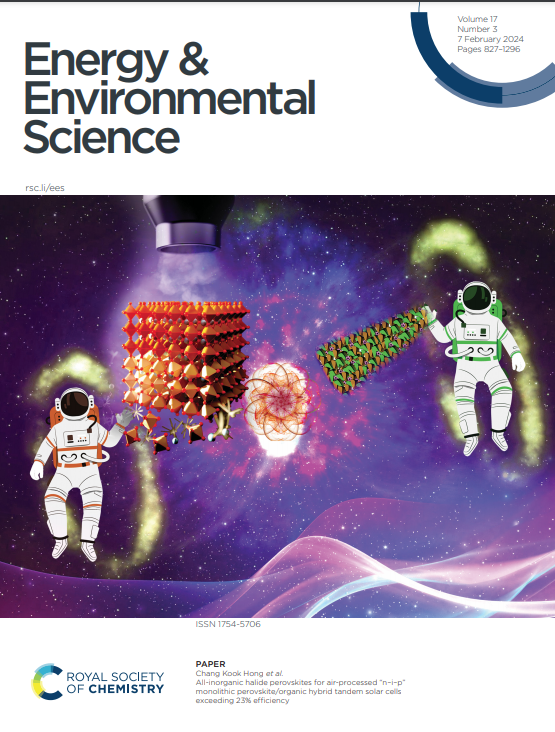由三元极性水凝胶电解质实现的-60至50°C超宽温度柔性锌-空气电池
IF 30.8
1区 材料科学
Q1 CHEMISTRY, MULTIDISCIPLINARY
引用次数: 0
摘要
柔性锌空气电池(FZABs)能够在很宽的温度范围内工作,是为下一代可穿戴电子产品供电的理想选择。然而,在极端温度下,FZABs的性能仍然不理想,这主要是由于水凝胶电解质(HEs)的冷冻和脱水导致离子传输受限。本文研制了一种由聚丙烯酰胺、聚对苯乙烯磺酸钠和乙二胺四乙酸四钠盐(PAM-PSS-EDTA HE)组成的新型三元极性水凝胶电解质,用于超宽温度FZABs。得益于PAM-PSS-EDTA HE中三元极性官能团的独特协同作用,水与官能团之间形成了更强、更多的氢键,从而增强了防冻和保水性。PAM-PSS-EDTA HE在25℃时离子电导率为348 mS cm-1,在-60℃时离子电导率为50.2 mS cm-1,冰点低于-100℃时具有优异的抗冻性能,在25℃下200小时保水率为83.4%,在50℃下100小时保水率为77%,与单组分或双组分HE相比具有显著的优势。此外,基于PAM-PSS-EDTA HE和NiFe-OLC电催化剂的FZABs在-60 ~ 50°C的超宽温度范围内表现出优异的性能,在-60°C和50°C下表现出4000次和400次的超长循环寿命。这项工作为开发用于广温FZABs的高性能水凝胶电解质提供了有价值的见解。本文章由计算机程序翻译,如有差异,请以英文原文为准。
-60 to 50 °C Ultrawide-Temperature Flexible Zinc-Air Batteries Enabled by a Ternary Polar Hydrogel Electrolyte
Flexible zinc-air batteries (FZABs) capable of operating across a broad temperature range are highly desirable for powering next-generation wearable electronics. However, FZABs still suffer from unsatisfied performance under extreme temperature, primarily due to the restricted ion transport caused by the freezing and dehydration of the hydrogel electrolytes (HEs). In this work, a new ternary polar hydrogel electrolyte composed of polyacrylamide, poly(sodium-p-styrenesulfonate) and ethylenediaminetetraacetic acid tetrasodium salt (PAM-PSS-EDTA HE) has been developed for ultrawide-temperature FZABs. Benefiting from the unique synergistic effect of the ternary polar functional groups in PAM-PSS-EDTA HE, stronger and more numerous hydrogen bonds between water and the functional groups are formed, leading to enhanced anti-freezing and water-retention properties. The PAM-PSS-EDTA HE achieves high ionic conductivities of 348 mS cm-1 at 25 °C, 50.2 mS cm-1 at -60 °C, excellent anti-freezing performance with freezing point below -100 °C, and outstanding water-retention ratio of 83.4 % after 200 hours at 25 °C, 77 % after 100 hours at 50 °C, demonstrating a significant superiority over single or double component HEs. Furthermore, FZABs based on PAM-PSS-EDTA HE and NiFe-OLC electrocatalyst demonstrate excellent performance under ultrawide temperature range from -60 °C to 50 °C, and exhibit ultralong cycle lifes of 4000 cycles at -60 °C and 400 cycles at 50 °C. This work offers valuable insights for the development of high-performance hydrogel electrolytes for wide-temperature FZABs.
求助全文
通过发布文献求助,成功后即可免费获取论文全文。
去求助
来源期刊

Energy & Environmental Science
化学-工程:化工
CiteScore
50.50
自引率
2.20%
发文量
349
审稿时长
2.2 months
期刊介绍:
Energy & Environmental Science, a peer-reviewed scientific journal, publishes original research and review articles covering interdisciplinary topics in the (bio)chemical and (bio)physical sciences, as well as chemical engineering disciplines. Published monthly by the Royal Society of Chemistry (RSC), a not-for-profit publisher, Energy & Environmental Science is recognized as a leading journal. It boasts an impressive impact factor of 8.500 as of 2009, ranking 8th among 140 journals in the category "Chemistry, Multidisciplinary," second among 71 journals in "Energy & Fuels," second among 128 journals in "Engineering, Chemical," and first among 181 scientific journals in "Environmental Sciences."
Energy & Environmental Science publishes various types of articles, including Research Papers (original scientific work), Review Articles, Perspectives, and Minireviews (feature review-type articles of broad interest), Communications (original scientific work of an urgent nature), Opinions (personal, often speculative viewpoints or hypotheses on current topics), and Analysis Articles (in-depth examination of energy-related issues).
 求助内容:
求助内容: 应助结果提醒方式:
应助结果提醒方式:


